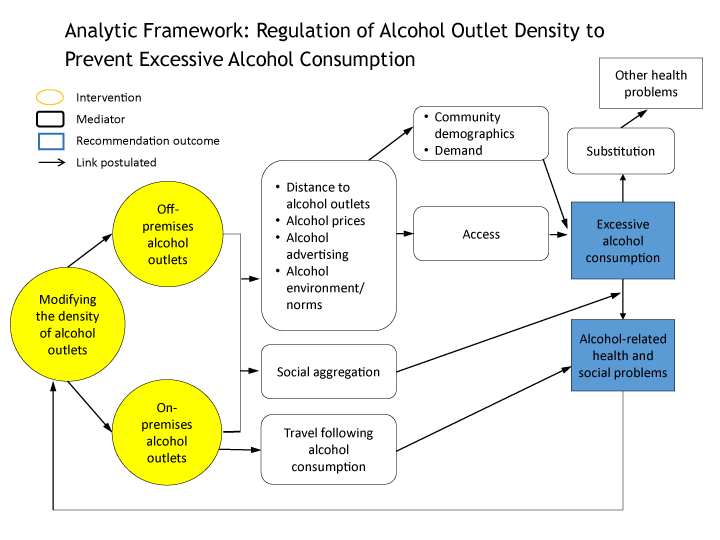- How is alcohol outlet density defined?
- Why would reducing the number of alcohol outlets in a geographic region reduce alcohol-related public health problems?
- What is the relationship between alcohol outlet density and alcohol-related problems, such as alcohol-related violence and alcohol-related motor vehicle crashes?
How is alcohol outlet density defined?
The Centers for Disease Control and Prevention (CDC) define alcohol outlet density as the number and concentration of alcohol retailers (such as bars, restaurants, or liquor stores) in an area.1,4 The term alcohol outlets includes all commercial businesses that sell and serve alcohol, whether for consumption on or off the premises.
Why would reducing the number of alcohol outlets in a geographic region reduce alcohol-related public health problems?
The Guide to Community Preventive Services hypothesized that outlet density affects excessive alcohol consumption and related problems by changing physical access to alcohol (referred to here as changing alcohol availability).1 Figure 1 illustrates this hypothesis, which is supported by extensive scientific literature.1,5,6

Outlet density can have a variety of effects on alcohol availability. For example, having fewer alcohol outlets reduces physical availability, thereby reducing convenient access to alcohol. As a result, more effort is required for individuals to purchase alcohol.1
Outlet density also affects social aggregation. A high concentration of outlets may offer more opportunities for drinkers to interact, which may result in more alcohol-related violence.1
Additionally, youth exposure to retail alcohol advertising may increase,1 which has been found to be associated with earlier drinking initiation and increased consumption among youth who already drink.7,8
What is the relationship between alcohol outlet density and alcohol-related problems, such as alcohol-related violence and alcohol-related motor vehicle crashes?
In 2009, The Guide to Community Preventive Services systematic review process was used to assess 88 scientific studies, leading to the conclusion that “greater outlet density is associated with increased alcohol consumption and related harms.”1 Evidence in the review indicates the following:
- State and local alcohol outlet density-related policy changes that increase alcohol outlet density and alcohol availability can significantly increase alcohol consumption and related problems.
- Privatizing state-run alcohol outlets increases both the number of retail alcohol establishments and sales of alcoholic beverages previously sold exclusively in the now-privatized state stores.
- Bans on alcohol sales, such as in dry counties, can substantially reduce excessive alcohol consumption and related problems, although their effectiveness depends on the availability of alcohol in surrounding areas.
- Reductions in outlet density may have additional community benefits, including reduced nuisance activities, loitering, vandalism, and prostitution.
Babor et al. published a second systematic review in 2010 that reached similar conclusions, highlighting the connection between outlet density and violence. The authors noted that the risks for violence increase when alcohol outlets are clustered in small geographic areas, such as entertainment districts.5 Research identifying alcohol outlets as hotspots for crime in a community supports this finding.6,9 Additionally, one study in Atlanta, Georgia, found that a relatively small reduction in alcohol outlet density is associated with substantial reductions in exposure to violent crime in neighborhoods with a high density of alcohol outlets.10

